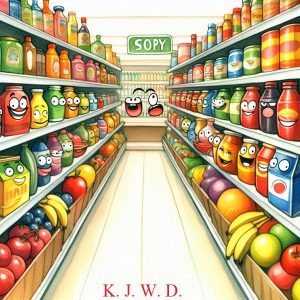I’ve never liked to grocery shop. Though, I became a good cook and baker. Go figure.
But to go grocery shopping variously? Count me in. Throw in some competition? There’s no way I passing this opportunity up! Maybe you remember, or can guess, what I’m talking about. YES, it’s the show “The Super Market Sweep’. To say I adored this show is a colossal understatement. It originally aired, at least in the Detroit area, from 1965-7. Super Market Sweep was a game show, and a rather typical one, as game shows go. I was a healthy kid and so didn’t miss much school. So, I likely watched it at most a few times. But, man, was I hooked. And even now, I recall watching it with delight.
The point of the game was to fill your grocery cart to the gills and check out, hoping to have the highest priced cart. I seem to recall that men and women participated. Contestants lined up at a starting line, with their hands on their grocery carts and their heads focused on filling the cart to the brim with the costliest items as fast as they could. As the starting bell rang, everyone raced through the store. However, the game always started with a mad dash to the meat department, as meat was the most expensive item.. Watching people shovel as much meat as they could into their carts, for me, was hilarious. I don’t remember where the herd went once the all the meat was gone. Perhaps, to the cheese department? From there, I only remember people scattered to scour the various aisles. Alas, the buzzer to stop rang and everyone raced to a checkout lane. With everyone’s basket completely filled and laden down, it was impossible to predict the winner. The person whose cart cost the most won the game and also got to keep all the food.
In truth, even at ten it was the inanity, and frantic energy that most appealed to me. I couldn’t quite discern the strategy, beyond loading up on meat. But I suspect contestants created a strategy for themselves. For some reason this show brought out my competitive streak. And, this was the reason I longed to play. For some crazy reason, I was certain I could beat any contestant and win. Mind you, I didn’t want the food. I just wanted to achieve the satisfaction of winning.
I wish I could remember how many frozen Birds Eye vegetable packages went into the carts. Birds Eyes frozen peas and carrots were a staple at our dinner table. I didn’t like them then and never have since. Needless to say, once on my own, they never appeared on any dinner plate I served.
I did a bit of research for this essay. To my utter amazement, the show continued in various forms from its original years. It actually ran sporadically until, yes, it’s true, just two years ago. Ending, presumably, in 2022. Now, the obvious thing to do is to find an old episode and see if it still retains the same thrill.





